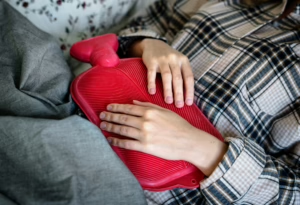Despite being a Gynaecological affliction that affects approximately 176 million people worldwide, there is still very little known about endometriosis. For years endo-warriors have been left misdiagnosed or not taken seriously by healthcare professionals, due to the widely misunderstood nature of the disorder and the range of misconceptions that have been perpetuated. People who suffer from endometriosis have often spent a lengthy amount of time challenging perceptions that they’re overreacting or just experiencing normal menstruation symptoms. The lack of support from the media and wider society towards menstruation, in general, has not helped the issue, with people afflicted often feeling too embarrassed to discuss their symptoms with their friends and doctors, simply choosing to suck it up and live with the pain. This does not have to be the case.
The first step to spreading awareness about endometriosis is challenging the fallacies that have been generated about the disorder. Knowledge is power, and with that power comes the ability to speak up, understand what is happening to your body and share that knowledge with your peers.
What Is Endometriosis?
Many of us may have heard of it in passing, but what actually is endometriosis? Endometriosis occurs when the tissue that normally grows on the lining of the uterus starts growing outside of it. This tissue (known as the endometrium) attaches itself to the ovaries and other organs inside the pelvis where it then begins to develop there. Yes, it is just as painful as it sounds.
Challenging The Misconceptions
But isn’t endometriosis just really bad period pain? No, it’s not. Unfortunately for a lot of people, this is the misconception that was shared by many doctors for years until recently, which meant that many suffering patients were left to just deal with it on their own. Okay, but I’m only in my 20’s. That means I’m safe from endometriosis, right? Unfortunately, that’s not the case. A 2011 Global Study of Women’s Health revealed that 2/3rd of women suffering from symptoms sought help before the age of 30 prior to being diagnosed with endometriosis. Endometriosis does not discriminate by age.
Am I The Only One?
Most definitely not. Despite the lack of awareness, endometriosis affects 1 out of every 10 women in their reproductive years. As endometriosis is still widely undiagnosed throughout the world this number may be significantly higher.
Check The Symptoms
Living with Endometriosis comes with various physical and mental challenges, some of the key warning signs for endometriosis include:
- Menstrual cramping that has increased in intensity over time.
- Pain during or after sex
- Intense pain in your pelvis that can start before menstruation and continue for days after
- Heavy menstrual bleeding that has increased over time
- Pain going to the bathroom, especially during menstruation
What Causes It?
There is still no clear explanation for why the endometrium grows where it’s not supposed to. Some research theories indicate that people with endometriosis tend to have higher levels of inflammation and oxidative stress in their bodies. It is also believed that endometriosis is genetic, so if someone in your biological family has it, there is a chance it could be passed on to you as well.
Why Is Diagnosis So Difficult?
Because symptoms vary so greatly among people with endometriosis, there is not one clear-cut sign of endometriosis, and symptoms are often misinterpreted for bad period pain, or another disorder altogether. In addition, many women have no or little symptoms and don’t realize there is an issue until they try to fall pregnant. As a result most people aren’t diagnosed for 6-10 years after experiencing their first symptoms. It can take months, or even years of visits to healthcare professionals to reach a diagnosis, while people from certain minority groups, such as transgender & non-binary people, and African-American & Hispanic women may face difficulties in receiving a diagnosis due to discrimination in the healthcare system.
…So How Can It Be Diagnosed?
This varies depending on a range of factors including your symptoms and your healthcare professional’s approach. The majority of people are diagnosed based on their symptoms alone, while others who may be displaying more obscure, or completely absent symptoms may need to be officially diagnosed via a simple surgery called a laparoscopy.
Possible Complications
Infertility is one of the main difficulties associated with endometriosis. Being discovered in up to 50% of infertile women, it is also a reason that a large number of women find out that they have the disease. People with endo may also be at a higher risk of cardiovascular issues such as heart attacks and diseases. Being diagnosed ASAP can assist with treating these issues, reducing complications and improving the chances of living a healthy, functioning life.
If Diagnosed With Endometriosis Don’t Lose Hope!
Although there is no definitive cure, don’t freak out just yet! Diagnosis is a positive step towards being able to manage what has most likely been a painful burden on your life. The symptoms of endometriosis can be treated with medical therapy, surgery and lifestyle changes. Hormonal medications such as the pill can assist with reducing some of the nasty symptoms, and can manage them as long as you are taking the medication. A hysterectomy has been circulated by some sources as being a cure for endometriosis, but this is not always the case, as it is still possible to have the disease without a uterus. A hysterectomy can offer a solution to the pain for some, but for others, this may not last forever.
Endometriosis is also not a death sentence to your uterus, i.e. it does not equal infertility. It has been reported that 60-70% of people with endometriosis are fertile, so don’t give up hope the moment you are diagnosed.
Lastly, just know that you’re not alone! Even though the medical field is still not completely endo-positive, there are a range of international endometriosis support groups that are here to provide information, advice and outreach for people living with endometriosis and their families.












[…] Endometriosis, a disorder in which the tissue lining the uterus (the endometrium) grows outside of it […]